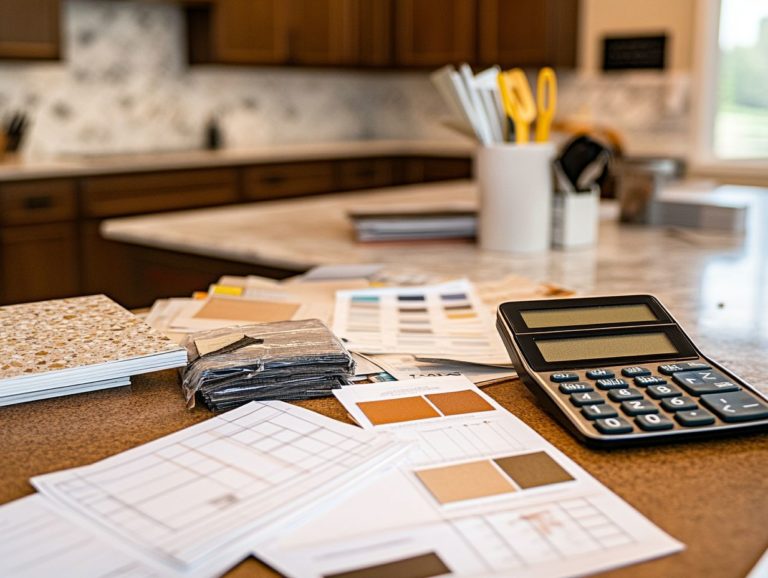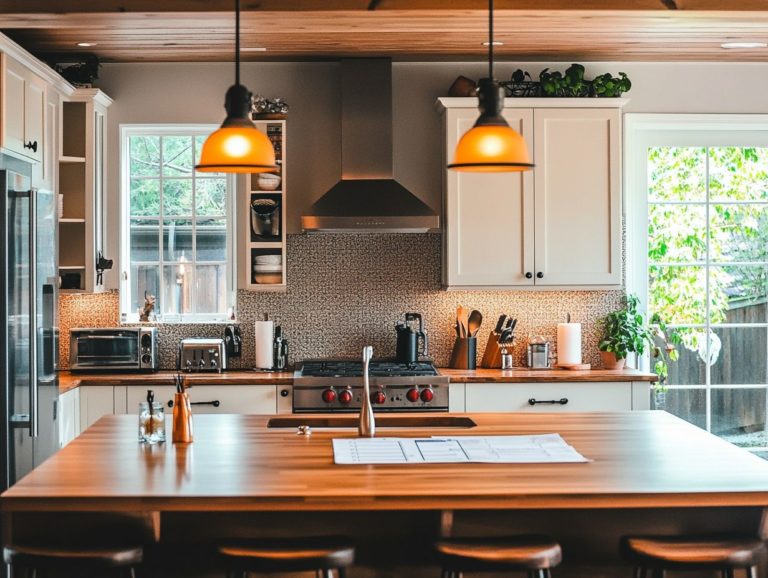5 Key Components of a Kitchen Remodel Budget
Planning a kitchen remodel can stir up a mix of excitement and anxiety, especially when it comes to budgeting. With a multitude of factors to juggle—from labor costs and materials to those pesky unexpected expenses—it’s all too easy to feel overwhelmed.
This article will help you master the five essential components of a kitchen remodel budget! It also delves into common pitfalls, shares savvy money-saving tips, and presents strategies for prioritizing your expenses.
Whether you’re embarking on your first remodel or you’re a seasoned veteran, you’ll uncover valuable insights to keep your project on track and within budget.
Contents
- Key Takeaways:
- 1. Research and Planning
- 2. Labor Costs
- 3. Materials and Supplies
- 4. Permits and Fees
- 5. Unexpected Expenses
- How Can You Create a Realistic Kitchen Remodel Budget?
- Frequently Asked Questions
- What are the 5 key components of a budget for a kitchen remodel?
- How much should I allocate for cabinets in my kitchen remodel budget?
- What factors should I consider when budgeting for countertops?
- Can I save money on appliances in my kitchen remodel budget?
- What miscellaneous expenses should I include in my kitchen remodel budget?
- Should I hire a professional for my kitchen remodel or DIY to save money?
Key Takeaways:
- Do your research and plan ahead to create a realistic kitchen remodel budget.
- Factor in labor costs, materials and supplies, permits and fees, and unexpected expenses.
- To save money, consider less expensive options and prioritize which aspects of the remodel are most important to you.
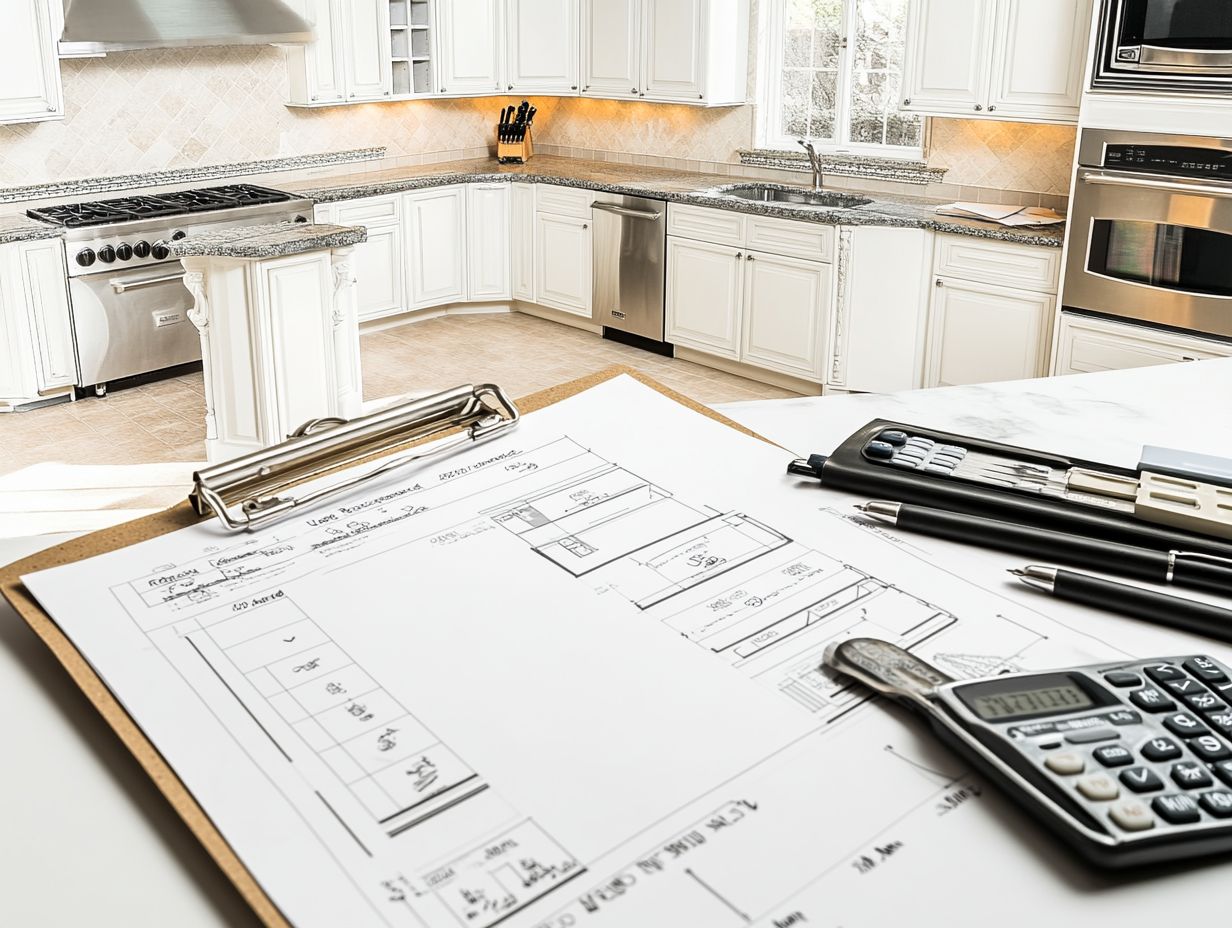
1. Research and Planning
When you embark on a kitchen remodeling project, effective research and meticulous planning are essential for achieving your desired outcome while staying within budget. Start by thoroughly assessing your current kitchen layout; this will give you valuable insights into what works and what doesn’t.
This evaluation will help you pinpoint areas in need of improvement and determine the best design options that align with your taste and functional needs. Explore a variety of materials that fit your financial plan to avoid unexpected costs later.
Consider energy-efficient appliances during planning. They help save on both initial costs and utility bills. This way, your kitchen becomes not just a stunning focal point but also an eco-friendly haven.
2. Labor Costs
Labor costs are key to your kitchen remodel. They can vary widely based on whether you DIY or hire professionals. Grasping this component is essential for anyone contemplating an upgrade, as the financial ramifications can heavily sway your decision-making process.
While the idea of rolling up your sleeves and taking on the project yourself might appear economical, the reality often unveils hidden costs—think tools, materials, and unforeseen complications that tend to pop up.
Conversely, hiring contractors typically incurs labor charges ranging from $50 to $150 per hour, depending on the job’s complexity and your location. While enlisting professional help guarantees quality and efficiency, those costs can accumulate quickly.
In this balancing act, DIY enthusiasts must carefully weigh the potential savings against the risks of mistakes, which can lead to unexpected expenses and delays.
3. Materials and Supplies
Choosing the right materials and supplies for your kitchen remodel can significantly impact both the aesthetic appeal and overall costs, enabling you to craft a stunning space without straining your budget.
As you explore options for cabinets, you’ll find a diverse range, from budget-friendly laminate finishes to luxurious wood veneers and custom designs that scream sophistication. In terms of countertops, the choices are just as vast.
You can opt for economical laminate or butcher block alternatives, or indulge in the timeless elegance of granite and quartz, both celebrated for their durability and beauty. Flooring options also vary widely; vinyl and laminate provide cost-effective solutions, while premium hardwoods and tiles can elevate your kitchen’s style.
Don’t overlook backsplashes; they can dramatically enhance your kitchen’s appearance. Consider ceramic tiles or even peel-and-stick options for budget-conscious projects that still pack a punch. By integrating energy-efficient windows and stylish lighting fixtures, you not only boost the kitchen’s aesthetic but also enhance functionality, creating a welcoming atmosphere.
And if you’re refurbishing existing materials, remember the transformative power of a fresh paint job or new hardware. These small updates can revitalize your space without emptying your wallet.
Don’t wait too long! Start your kitchen remodel planning today to ensure you get the results you desire!
4. Permits and Fees
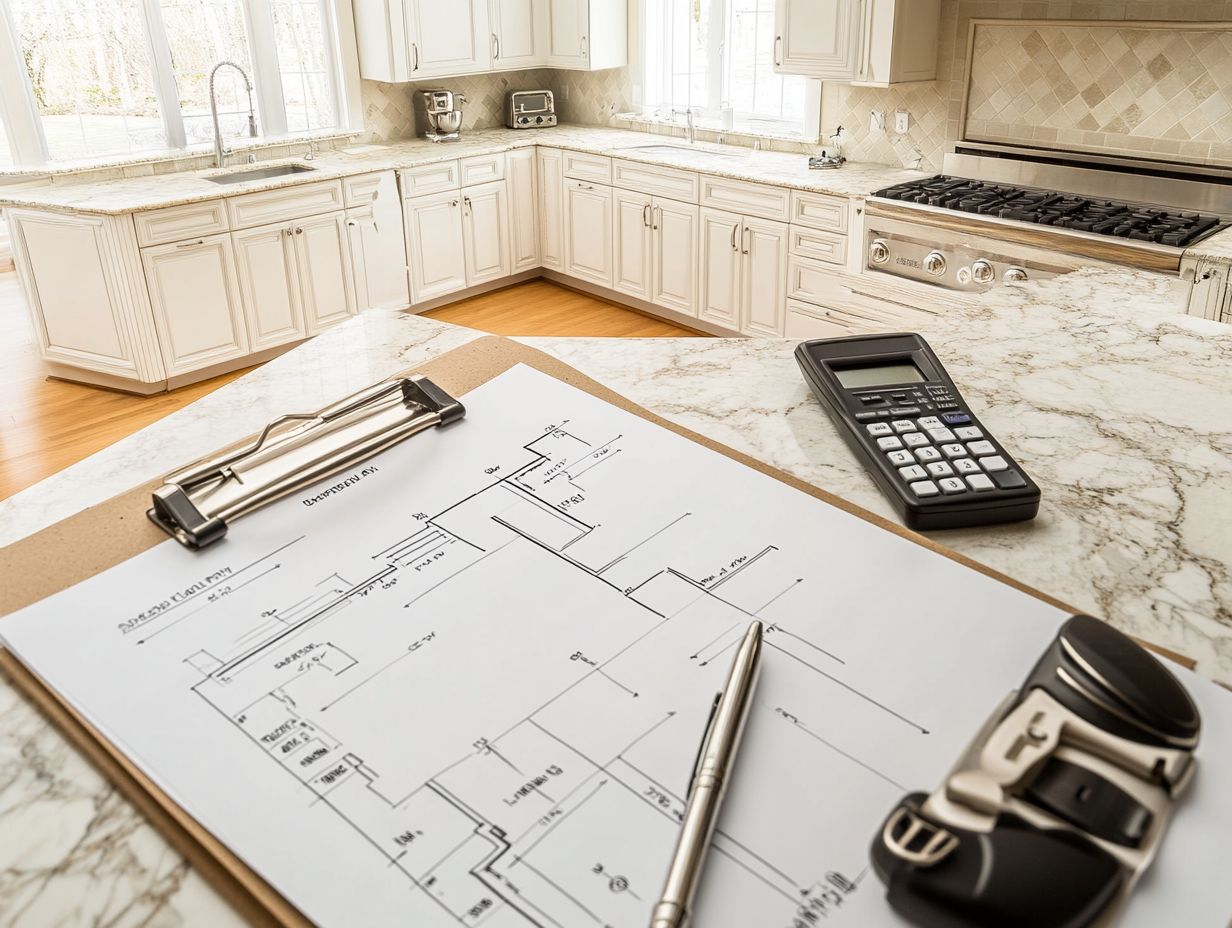
Securing the necessary permits and grasping the associated fees is essential in your kitchen remodeling journey, ensuring compliance with local regulations and helping you avoid costly delays.
Depending on the scope of your project, different types of permits may come into play. For example, a simple facelift might only require a straightforward renovation permit, whereas more extensive modifications—such as changes to plumbing or electrical systems—could demand more intricate permits.
It’s important for you to consider these costs, as they can significantly impact your overall budget. Skipping the right permits could lead to fines or the need for expensive revisions later on. Planning for these permit-related expenses will help pave the way for a smoother and more efficient renovation experience.
5. Unexpected Expenses
During a kitchen remodeling project, you may encounter unexpected expenses that can arise from hidden issues like outdated plumbing fixtures or the need to repair appliances, potentially derailing even the most carefully crafted budget.
These costs can accumulate rapidly, especially if structural issues such as water damage or pest infestations crop up during renovations. A thorough inspection is a smart move for homeowners, as it can help pinpoint potential problems early on.
Setting aside a contingency fund—typically around 10-20% of your total budget—will serve as a safety net for those surprise expenses. Don’t wait until it’s too late—prepare for unexpected costs now!
By planning for the unexpected, you can ensure that your dream kitchen becomes a reality without causing financial strain, allowing for any necessary adjustments mid-project without the burden of overwhelming stress.
How Can You Create a Realistic Kitchen Remodel Budget?
Creating a realistic kitchen remodel budget requires you to thoughtfully consider various factors, including the costs associated with the renovation, the potential for DIY projects, and the inclusion of energy-efficient appliances that can save you money in the long run.
To start, it’s essential for you to conduct thorough research on average costs for materials, labor, and appliances. Understanding these financial baselines will help you avoid any unexpected expenses that could derail your plans. For instance, dishwashers and refrigerators can have a wide range of prices and efficiencies, making it crucial for you to make informed choices.
As you map out your remodel, take the time to distinguish between your needs and wants, prioritizing essentials first, such as functionality and safety. This approach often leads to more disciplined spending.
By prioritizing energy-efficient appliances, you’ll not only lower your utility bills over time but also enhance the overall value of your home, making it a wise investment both now and in the future.
What Are the Most Expensive Aspects of a Kitchen Remodel?
Understanding the most significant expenses in a kitchen remodel gives you the power to allocate your budget wisely and make informed decisions on where to invest during the renovation process.
By evaluating key elements such as cabinetry, which often consumes a considerable chunk of your budget, and countertops that can set the overall aesthetic, you can prioritize your expenditures effectively.
Weighing the costs of high-end appliances against more budget-friendly alternatives can lead to substantial savings or improved functionality. High-end appliances are generally more efficient and durable, making them worth considering for your investment.
It’s equally vital to recognize the differences between undertaking a full-scale remodel and opting for a budget-conscious update. While a comprehensive renovation may offer a higher return on investment, it often involves a more substantial initial financial commitment, which can influence your overall expenses in the long run.
How Can You Save Money on a Kitchen Remodel?

Saving money on a kitchen remodel is achievable with strategic planning. Choose cheaper materials, consider cabinet refacing—updating cabinets without replacing them completely—and tackle painting cabinets and walls yourself.
By focusing on budget-friendly materials like laminate or vinyl instead of costly hardwoods, you can slash costs dramatically while still maintaining an appealing aesthetic.
Embrace DIY projects for backsplash installation or decorative accents to save money and add a personal touch. Reuse or refurbish existing elements, such as updating old hardware or repurposing furniture, to achieve a fresh look while keeping expenses in check.
Prioritizing savings in this way allows you to be cost-effective without sacrificing overall quality or design.
Top Budgeting Mistakes to Avoid
Many homeowners stumble into common pitfalls when budgeting for a kitchen remodel. They often underestimate costs or overlook unexpected expenses, which can create financial strain and lead to delays.
For instance, if you neglect to set aside a contingency fund—typically recommended at 10-20% of your overall budget—you may find yourself in a tight spot when unforeseen issues arise.
Accurately price materials and labor to ensure that your choices align with your budget while maintaining quality. Conduct thorough research on potential costs and obtain multiple quotes. This helps in making informed decisions that pave the way for a smoother renovation experience.
How to Prioritize Your Kitchen Remodel Budget
Prioritizing your budget is crucial for ensuring your renovation reflects your lifestyle and financial aspirations. Focus on elements that truly matter to you.
Establish a framework that divides the remodel into three categories: layout, appliances, and finishes.
Start by evaluating the layout to see how well it accommodates your daily routines and entertaining needs. A functional layout often serves as the cornerstone of a harmonious kitchen.
Next, scrutinize your appliance selection, focusing on energy efficiency and usability. Prioritize high-quality items that align with your cooking habits.
While finishes like cabinetry and countertops enhance aesthetics, they should complement the space’s functionality.
Evaluate each category systematically to ensure your renovation embodies both practicality and your unique style.
Tips for Sticking to Your Kitchen Remodel Budget
Sticking to your kitchen remodel budget requires disciplined planning and flexibility to adapt to unexpected expenses.
Regularly review your budget to maintain a clear understanding of costs and necessary adjustments. Track your expenses meticulously—whether through a budgeting app or a spreadsheet—for real-time insights into spending patterns.
Create a contingency plan as a safeguard against unforeseen costs during renovations. By setting aside a percentage of your budget for emergencies, you can confidently navigate surprises and achieve a successful remodel without financial strain.
Frequently Asked Questions
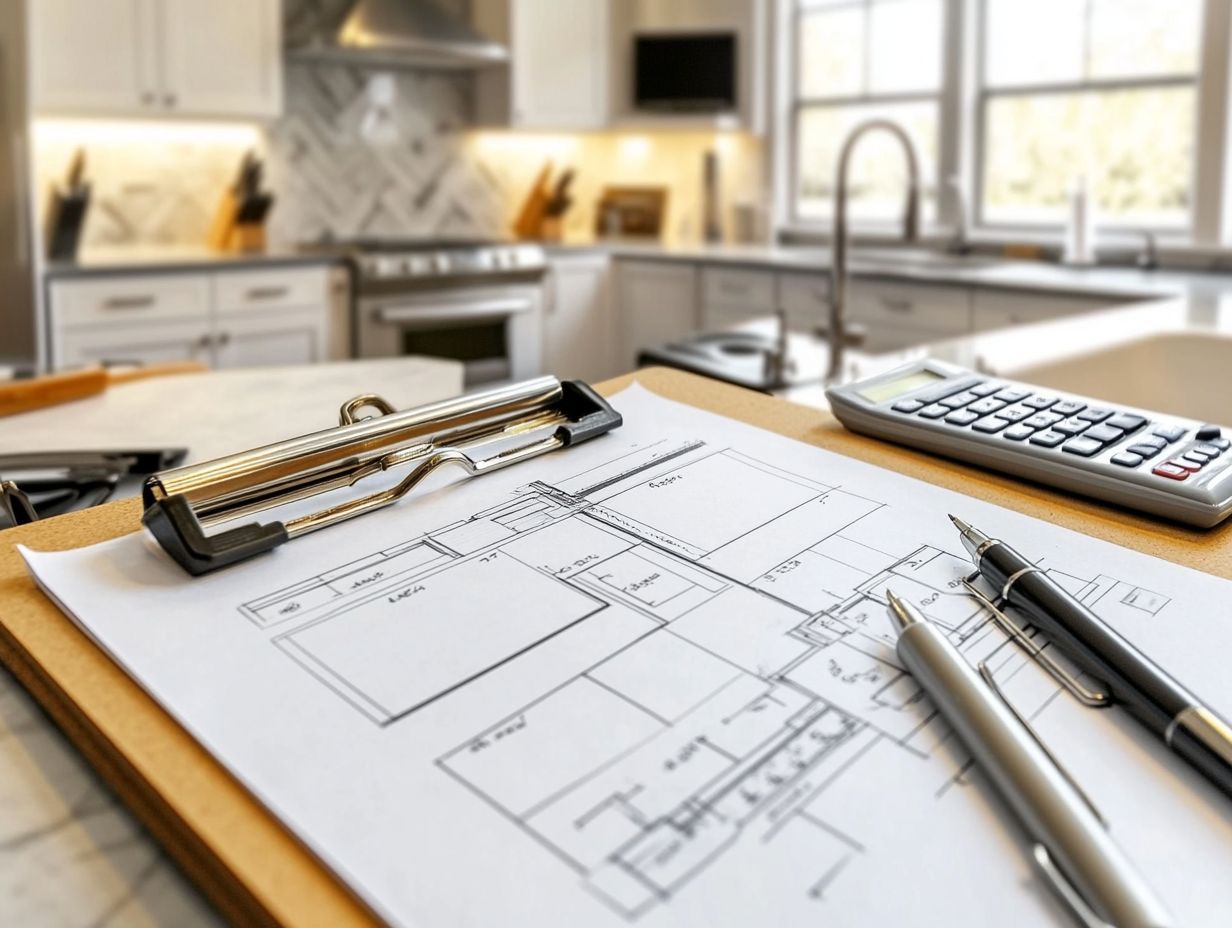
What are the 5 key components of a budget for a kitchen remodel?
The 5 key components are cabinets, countertops, appliances, labor, and miscellaneous expenses. These make up the majority of a kitchen remodel budget and should be carefully considered when creating a budget plan.
How much should I allocate for cabinets in my kitchen remodel budget?
Cabinets usually take the biggest slice of your kitchen remodel budget. They can account for 30-40% of the total cost, including both cabinets and installation.
What factors should I consider when budgeting for countertops?
Countertop costs vary widely based on material, size, and design complexity. Think about materials like granite, quartz, or laminate, as well as your kitchen’s size and any special features like a wall behind the counter.
Can I save money on appliances in my kitchen remodel budget?
You can save on appliances by choosing budget-friendly brands or gently used items. Remember, though, these are long-term investments; spending a little more can get you better quality and energy efficiency!
What miscellaneous expenses should I include in my kitchen remodel budget?
Don’t forget about additional costs when budgeting! This can include permits, design fees, and unexpected repairs. It’s smart to set aside 10-20% of your budget for these miscellaneous expenses.
Should I hire a professional for my kitchen remodel or DIY to save money?
While DIY can save cash, hiring a pro often leads to better results. Professionals ensure the job is done right and can save you money in the long run by avoiding costly mistakes. They also bring valuable design ideas to make your dream kitchen a reality!

